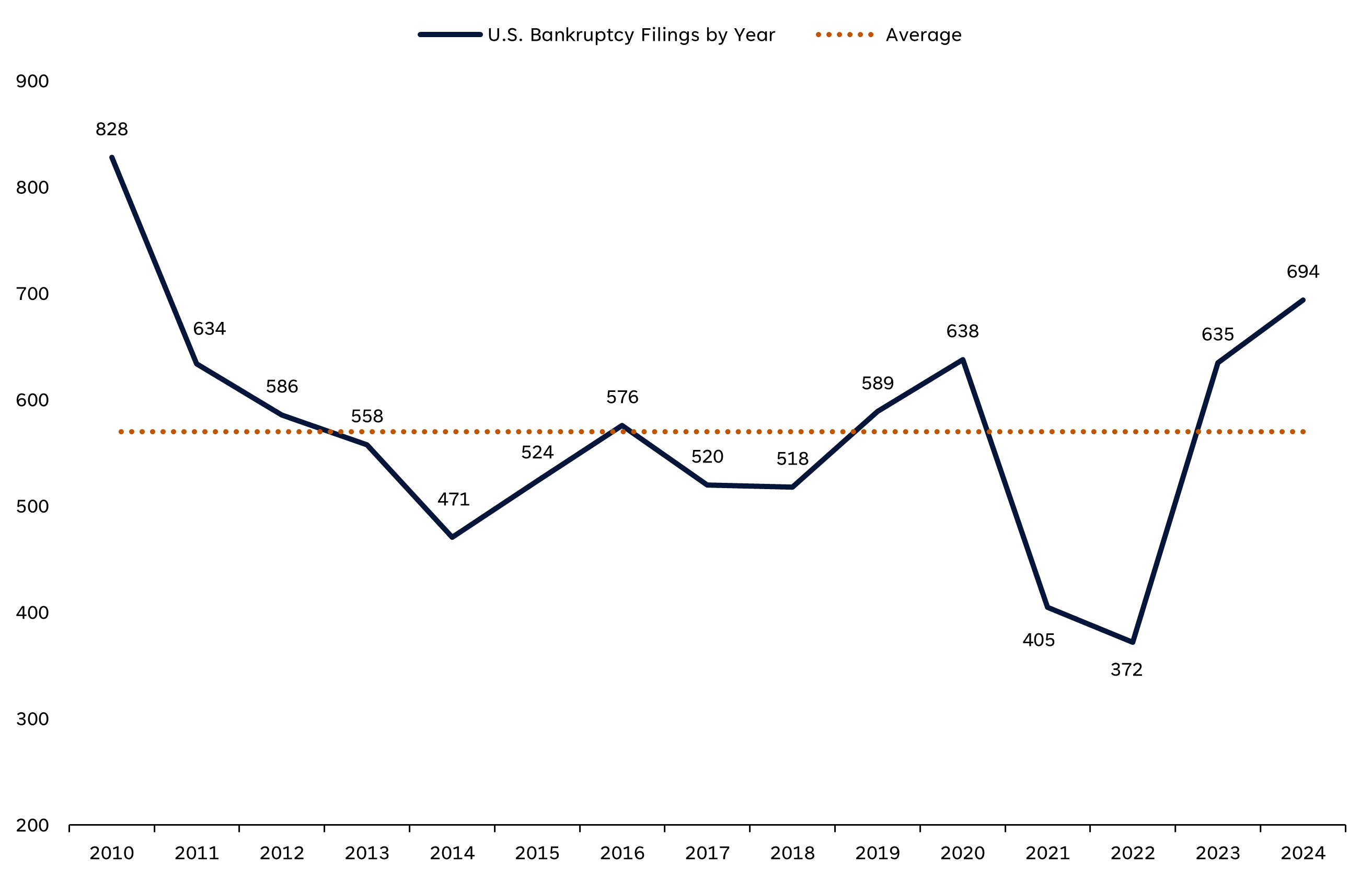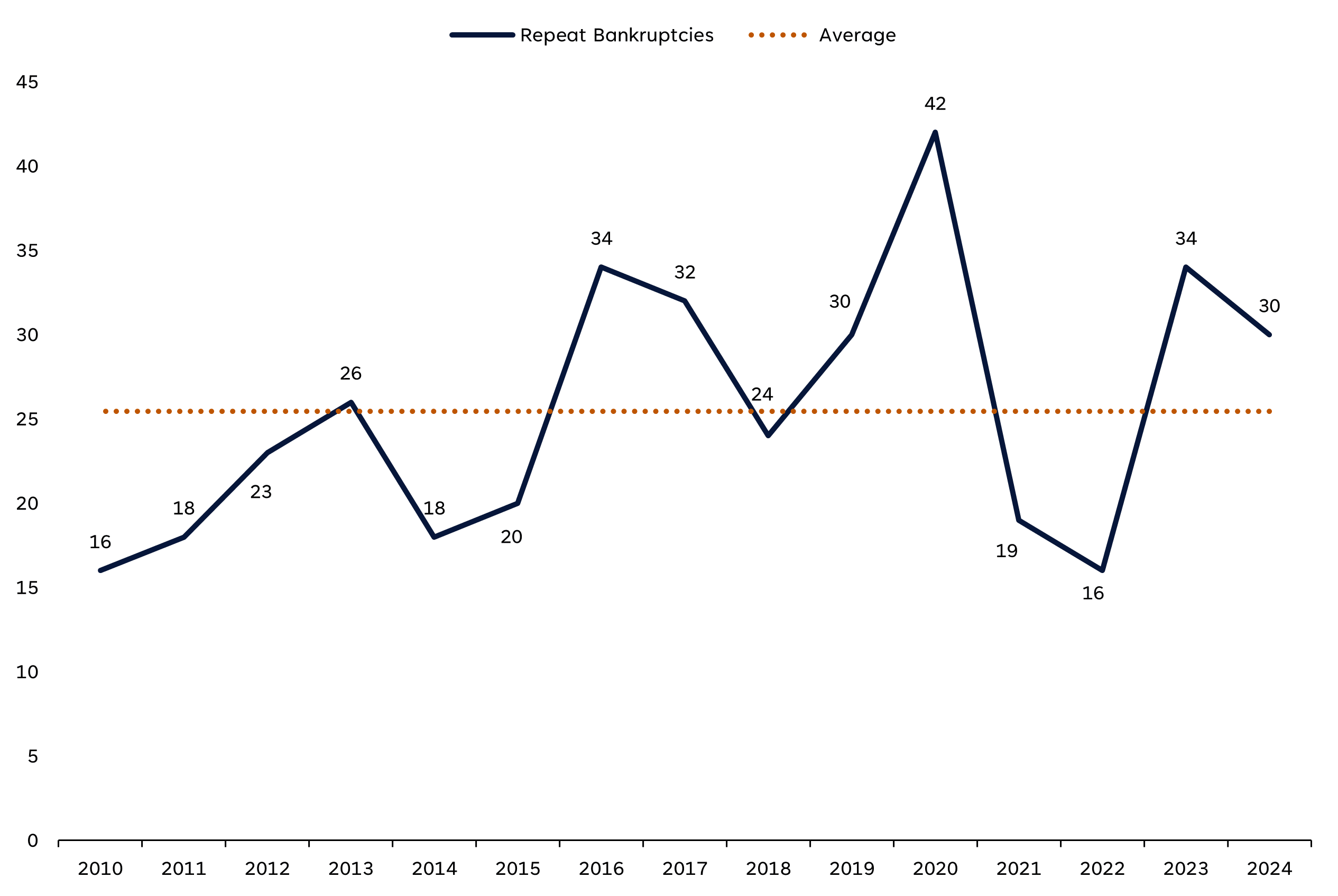Last year, drivers of risk appetite included the much-anticipated rate cuts from the Federal Reserve and a robust economy that consistently exceeded expectations. However, while the economy generally surpassed consensus expectations leading up to and since the first Fed rate cut in September, rising corporate bankruptcy filings continued to bubble beneath the surface.
Recent data from S&P Global Market Intelligence revealed that corporate bankruptcies reached a 14-year high last year, with 694 public and private companies filing for bankruptcy in 2024. This surpassed the recent high of 638 in 2020, when the U.S. and global economies trudged through a worldwide pandemic, marking the largest number of bankruptcy filings since 2010 when 828 companies went under in the wake of the global financial crisis. Filings came in at a steady clip throughout 2024, with more than 57 companies announcing bankruptcy in nine out of 12 months, peaking at 70 during the month of June. The consumer discretionary sector bore the brunt of the bankruptcies with 109 companies, or nearly 16% of total filings. High-profile bankruptcies included Spirit Airlines (OTC:SAVEQ), Red Lobster, Tupperware (OTC:TUPBQ), and Big Lots (NYSE:BIG).
U.S. Bankruptcy Filings by Year

Despite the 100 basis points (1.0%) of monetary easing during the fourth quarter, businesses — especially highly leveraged ones — continued to face pressure from elevated interest rates last year. Further, financial stress on businesses is evident based on recovery rates (the percentage of defaulted debt a lender recovers) for priority lenders reaching multi-year lows. On the consumer front, the persistently elevated cost of goods and services weighed on consumer demand. In recent quarters, consumers maintained robust spending and data surprised to the upside, anchored by middle- and upper-income households.
But looking ahead, companies within the consumer discretionary sector could remain vulnerable. The Fed is signaling a slower and shallower rate-cutting path this year, and consumer sentiment remains tepid, indicated by mixed survey results. December marked the largest one-month drop in the Conference Board Consumer Confidence Expectations Index since November 2020 (measuring consumers’ short-term outlook for income, business, and labor market conditions).
Although the data may not be as condemning as it seems. Consumer expectation surveys have been tainted by politics, and bankruptcy filings were once again elevated by repeat filings. Repeat bankruptcy filings remained above the long-term average for the second consecutive year, and while this can be a flag of an overheating economy, lingering struggling companies could also be a factor. Chapter 11 bankruptcy can be a tactical maneuver for fledging retailers, as some go to court to have their debts written down and attempt to restructure.
But since lower-income households feel the squeeze from sticky inflation and businesses migrate towards e-commerce, bankruptcy filings have not been the cure for some floundering companies attempting to adapt. As in the case of Party City, the party goods retailer used its 2023 bankruptcy to renegotiate hundreds of leases, cut debt, and close unprofitable stores. However, just 14 months later, the corporation was forced to file again. Other repeat filers include teen apparel store rue21 Inc. and outdoor apparel provider Eastern Mountain Sports, both of which filed for bankruptcy for the third time last year.

Conclusion
The continued rise in corporate bankruptcies is noteworthy, but borrowing conditions will likely continue to improve as the Fed extends its policy easing in 2025, albeit at a slower pace than initially expected. Additionally, consumer spending is likely to remain robust as inflation continues to moderate and personal and discretionary income remains intact.
From a market perspective, we expect stocks to move modestly higher in 2025 while acknowledging reasonable upside and downside scenarios. Upside support could come from economic growth, a supportive Fed, strong corporate profits, and business-friendly policies from the Trump administration. The most likely downside scenarios involve re-accelerating inflation, higher interest rates, and geopolitical threats that do economic harm.
Additional content provided by Brian Booe, Associate Analyst, Research.
Important Disclosures
This material is for general information only and is not intended to provide specific advice or recommendations for any individual. There is no assurance that the views or strategies discussed are suitable for all investors. To determine which investment(s) may be appropriate for you, please consult your financial professional prior to investing.
Investing involves risks including possible loss of principal. No investment strategy or risk management technique can guarantee return or eliminate risk.
Indexes are unmanaged and cannot be invested directly. Index performance is not indicative of the performance of any investment and does not reflect fees, expenses, or sales charges. All performance referenced is historical and is no guarantee of future results.
Asset Class Disclosures –
International investing involves special risks such as currency fluctuation and political instability and may not be suitable for all investors. These risks are often heightened for investments in emerging markets.
Bonds are subject to market and interest rate risk if sold prior to maturity.
Municipal bonds are subject and market and interest rate risk and potentially capital gains tax if sold prior to maturity. Interest income may be subject to the alternative minimum tax. Municipal bonds are federally tax-free but other state and local taxes may apply.
Preferred stock dividends are paid at the discretion of the issuing company. Preferred stocks are subject to interest rate and credit risk. They may be subject to a call features.
Alternative investments may not be suitable for all investors and involve special risks such as leveraging the investment, potential adverse market forces, regulatory changes and potentially illiquidity. The strategies employed in the management of alternative investments may accelerate the velocity of potential losses.
Mortgage backed securities are subject to credit, default, prepayment, extension, market and interest rate risk.
High yield/junk bonds (grade BB or below) are below investment grade securities, and are subject to higher interest rate, credit, and liquidity risks than those graded BBB and above. They generally should be part of a diversified portfolio for sophisticated investors.
Precious metal investing involves greater fluctuation and potential for losses.
The fast price swings of commodities will result in significant volatility in an investor's holdings.
